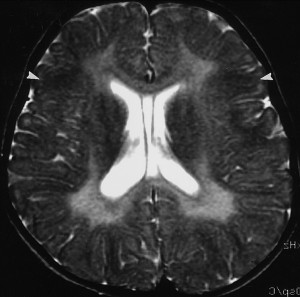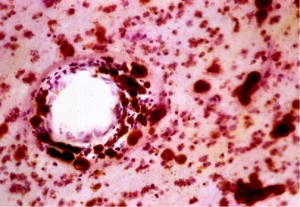Metachromatic Leukodystrophy (MLD) is a rare genetic disorder that leads to progressive deterioration of the functioning of the brain and the nerves. Find out all about this disease, including its causes, symptoms, diagnosis and treatment.
Metachromatic Leukodystrophy Definition
Page Contents
- 1 Metachromatic Leukodystrophy Definition
- 2 Metachromatic Leukodystrophy ICD9 Code
- 3 Metachromatic Leukodystrophy (MLD) Synonyms
- 4 Metachromatic Leukodystrophy Forms
- 5 Metachromatic Leukodystrophy Causes
- 6 Metachromatic Leukodystrophy Symptoms
- 7 Metachromatic Leukodystrophy Diagnosis
- 8 Metachromatic Leukodystrophy Treatment
- 9 Metachromatic Leukodystrophy Prognosis
- 10 Metachromatic Leukodystrophy Life Expectancy
- 11 Metachromatic Leukodystrophy Research
- 12 Metachromatic Leukodystrophy Prevention
It is one of the common metabolic disorders belonging to a group of diseases known as Leukodystrophy. This hereditary condition affects the major areas of the nervous system of the affected patient. It causes damage to the myelin sheath – a type of protective covering for the nerve cells. As the disease becomes severe, the ability to talk, walk, hear and see worsens progressively in an affected individual. In a few cases, patients stop responding and become paralyzed.
The disease occurs in 1 out of every 40000 to 160000 people residing in US.
Metachromatic Leukodystrophy ICD9 Code
The ICD9 code for this disorder is 330.0.
Metachromatic Leukodystrophy (MLD) Synonyms
This ailment is also known by many other names like:
Picture 1 – Metachromatic Leukodystrophy
- ARSA
- Diffuse Cerebral Sclerosis
- Late-Onset Metachromatic Leukodystrophy
- Metachromatic Form of Diffuse Cerebral
- Sulfatide Lipidosis
- Arylsulfatase A Deficiency
- Cerebroside Sulfatase Deficiency
- Greenfield Disease
- Metachromatic Leukoencephalopathy
- MLD
Metachromatic Leukodystrophy Forms
MLD is mainly categorized into three forms, which are commonly found to affect individuals born in the United States. These are:
Infantile Form
It is the most common form of MLD occurring among US patients. It generally develops between 12 and 20 months post-birth. Children affected by this disorder can barely walk in their first year and often turn comatose. In a few cases, sufferers die when they turn 5 years old.
Juvenile Form
This form has an onset between 3 and 10 years of age. It results in degradation of mental capabilities and makes sufferers perform badly in school. Affected individuals also suffer from Dementia.
Adult Form
It arises after a patient turns 16 years of age. It begins as an advanced Dementia or a psychiatric medical condition in the body of a patient.
Metachromatic Leukodystrophy Causes
This disorder is the result of an enzyme deficiency known as Arylsulfatase A. An absence of this enzyme results in a build-up of sulfatide (fatty acids present within the brain) in various body tissues and damage of the myelin sheath of the nervous system. The myelin sheath is responsible for protecting the nerve fibers. The peripheral and central nervous system fails to work properly in the absence of this sheath. This, in turn, leads to Demyelination – a process that affects the link of communication between the brain and nerves. The lack of communication leads to the development of MLD.
Metachromatic Leukodystrophy Symptoms
This medical disorder is characterized by certain symptoms, which indicate the presence of MLD in the body. Such symptoms send a warning signal to the patient, making it necessary for them to consult a doctor urgently. These include problems like:
- Abnormal high muscle tone
- Abnormal muscular movements
- Behavioral problems
- Reduced mental function
- Incontinence
- Irritability
- Nerve function problems
- Loss of muscle control
- Seizures
- Speech difficulties, slurring
- Personality changes
- Poor school performance
- Frequent falls
- Inability to perform normal tasks
- Swallowing difficulty
- Decreased muscle tone
- Difficulty walking
- Feeding difficulties
Metachromatic Leukodystrophy Diagnosis
A number of medical tests are available for proper diagnosis of MLD. These diagnostic exams help physicians understand the intensity of the disease more closely and provide remedy for the same. The tests that determine the existence of MLD involve:
- Skin or blood tests, which are used to check low levels of arylsulfatase A enzyme activity
- CT scan
- Nerve biopsy
- MRI test, to check for any kind of deformity
- DNA tests for ARSA genes
- Lumbar puncture, which is used to check the fluid covering the spinal cord.
- Urinalysis, which is used to check the possible existence of MLD and high level of sulfatides
- Nerve velocity conduction studies
Metachromatic Leukodystrophy Treatment
There is no standard cure for this disorder. MLD is actually an incurable disease. However, proper bone marrow transplantation can be done in a few patients. This treatment procedure is quite risky. Hence, it is not preferred by everyone.
Picture 2 – Metachromatic Leukodystrophy Image
There are other treatment options that can help relieve the symptoms of this syndrome. Muscle contraction and seizures can be cured by proper medication. Physical therapy can also help patients overcome this disease. Feeding tubes, walking aids and wheelchairs are also helpful in treating the symptoms of MLD.
With the advent of innovative therapies, doctors find it easier to perform symptomatic treatment for this ailment. Therapeutic treatment for MLD involves Enzyme Replacement Therapy (ERT), Gene Therapy and Enzyme Enhancement Therapy (EET).
Metachromatic Leukodystrophy Prognosis
The condition has a very bad outcome when compared to other similar disorders. In most cases, children affected by the infantile form die by the age of 5. The development of the symptoms in adult and juvenile form is much slower and affected patients manage to live for more than a decade.
Metachromatic Leukodystrophy Life Expectancy
The lifespan of MLD sufferers differ depending on what age the disease arises in an individual. According to medical practitioners, however, sufferers of this medical condition usually survive for 3-20 years.
Metachromatic Leukodystrophy Research
NINDS, National Institute of Neurological Disorders and Stroke, is a major part of National Institute of Health. The organization conducts extensive research programs on various lipid storage diseases. It also conducts various other research programs at the major medical organizations spread across the nation.
Metachromatic Leukodystrophy Prevention
If you have a family history of this syndrome, and considering having a child, genetic counseling is highly recommended for you.
Metachromatic Leukodystrophy is a complicated genetic disorder of the nervous system. If proper care or treatment is not given in time, the condition can significantly affect the brain and impair intellectual activities. Hence, it is necessary to consult a doctor immediately as soon as the symptoms of this disorder become apparent.
References:
http://www.ncbi.nlm.nih.gov/pubmedhealth/PMH0002185/
http://www.ninds.nih.gov/disorders/metachromatic_leukodystrophy/metachromatic_leukodystrophy.htm
http://en.wikipedia.org/wiki/Metachromatic_leukodystrophy#Symptoms_and_forms
http://www.umm.edu/ency/article/001205prv.htm


